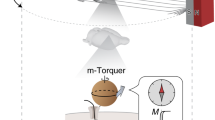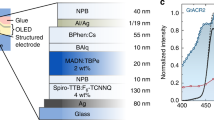Abstract
Precisely timed activation of genetically targeted cells is a powerful tool for the study of neural circuits and control of cell-based therapies. Magnetic control of cell activity, or ‘magnetogenetics’, using magnetic nanoparticle heating of temperature-sensitive ion channels enables remote, non-invasive activation of neurons for deep-tissue applications and freely behaving animal studies. However, the in vivo response time of thermal magnetogenetics is currently tens of seconds, which prevents precise temporal modulation of neural activity. Moreover, magnetogenetics has yet to achieve in vivo multiplexed stimulation of different groups of neurons. Here we produce subsecond behavioural responses in Drosophila melanogaster by combining magnetic nanoparticles with a rate-sensitive thermoreceptor (TRPA1-A). Furthermore, by tuning magnetic nanoparticles to respond to different magnetic field strengths and frequencies, we achieve subsecond, multichannel stimulation. These results bring magnetogenetics closer to the temporal resolution and multiplexed stimulation possible with optogenetics while maintaining the minimal invasiveness and deep-tissue stimulation possible only by magnetic control.
This is a preview of subscription content, access via your institution
Access options
Access Nature and 54 other Nature Portfolio journals
Get Nature+, our best-value online-access subscription
$29.99 / 30 days
cancel any time
Subscribe to this journal
Receive 12 print issues and online access
$259.00 per year
only $21.58 per issue
Buy this article
- Purchase on Springer Link
- Instant access to full article PDF
Prices may be subject to local taxes which are calculated during checkout





Similar content being viewed by others
Data availability
The main data supporting the results of this study are available within the paper and its Supplementary information. The raw videos generated for the study are too large for public sharing, but are available for research purposes from the corresponding authors upon reasonable request.
Code availability
FlyTracker (Perona Lab, CalTech, v.1.0.5) was used to track the wing angle and position of flies within their respective chambers, and is publicly available online (https://www.vision.caltech.edu/datasets/). DeepLabCut (Mathis Lab, v.2.2.b9) was used to track fly wing angle and position for videos with shadows, and is publicly available online (http://www.mackenziemathislab.org/deeplabcut). Microsoft excel (v.16.54) was used for simple SLP and selectivity calculations. FLIR research studio (v.2.0) was used for thermal imaging.
References
Huang, H., Delikanli, S., Zeng, H., Ferkey, D. M. & Pralle, A. Remote control of ion channels and neurons through magnetic-field heating of nanoparticles. Nat. Nanotechnol. 5, 602–606 (2010).
Munshi, R. et al. Magnetothermal genetic deep brain stimulation of motor behaviors in awake, freely moving mice. eLife https://doi.org/10.7554/eLife.27069 (2017).
Chen, R., Romero, G., Christiansen, M. G., Mohr, A. & Anikeeva, P. Wireless magnetothermal deep brain stimulation. Science 347, 1477–1480 (2015).
Duret, G. et al. Magnetic entropy as a proposed gating mechanism for magnetogenetic ion channels. Biophys. J. 116, 454–468 (2019).
Stanley, S. A. et al. Radio-wave heating of iron oxide nanoparticles can regulate plasma glucose in mice. Science https://doi.org/10.1126/science.1216753 (2012).
Stanley, S. A., Sauer, J., Kane, R. S., Dordick, J. S. & Friedman, J. M. Remote regulation of glucose homeostasis in mice using genetically encoded nanoparticles. Nat. Med. 21, 92–98 (2015).
Wheeler, M. A. et al. Genetically targeted magnetic control of the nervous system. Nat. Neurosci. 19, 756–761 (2016).
Wang, G. et al. Revaluation of magnetic properties of Magneto. Nat. Neurosci. 23, 1047–1050 (2020).
Kole, K. et al. Assessing the utility of Magneto to control neuronal excitability in the somatosensory cortex. Nat. Neurosci. 23, 1044–1046 (2020).
Schroll, C. et al. Light-induced activation of distinct modulatory neurons triggers appetitive or aversive learning in Drosophila larvae. Curr. Biol. 16, 1741–1747 (2006).
Gradinaru, V. et al. Targeting and readout strategies for fast optical neural control in vitro and in vivo. J. Neurosci. https://doi.org/10.1523/JNEUROSCI.3578-07.2007 (2007).
Liu, Y. et al. Optogenetic study of the response interaction among multi-afferent inputs in the barrel cortex of rats. Sci. Rep. 9, 3917 (2019).
Young, J. H. H., Wang, M.-T. T. & Brezovich, I. A. A. Frequency/depth-penetration considerations in hyperthermia by magnetically induced currents. Electron. Lett. https://doi.org/10.1049/el:19800255 (1980).
Gregurec, D. et al. Magnetic vortex nanodiscs enable remote magnetomechanical neural stimulation. ACS Nano 14, 8036–8045 (2020).
Lee, J. et al. Non-contact long-range magnetic stimulation of mechanosensitive ion channels in freely moving animals. Nat. Mater. https://doi.org/10.1038/s41563-020-00896-y (2021).
Hamada, F. N. et al. An internal thermal sensor controlling temperature preference in Drosophila. Nature 454, 217–220 (2008).
Luo, J., Shen, W. L. & Montell, C. TRPA1 mediates sensation of the rate of temperature change in Drosophila larvae. Nat. Neurosci. 20, 34–41 (2017).
Panzano, V. C., Kang, K. & Garrity, P. A. Infrared snake eyes: TRPA1 and the thermal sensitivity of the snake pit organ. Sci. Signal. 3, pe22 (2010).
Laursen, W. J., Anderson, E. O., Hoffstaetter, L. J., Bagriantsev, S. N. & Gracheva, E. O. Species-specific temperature sensitivity of TRPA1. Temp. Multidiscip. Biomed. J. 2, 214–226 (2015).
Luo, L. et al. Navigational decision making in Drosophila thermotaxis. J. Neurosci. https://doi.org/10.1523/JNEUROSCI.4090-09.2010 (2010).
Rosenzweig, M. et al. The Drosophila ortholog of vertebrate TRPA1 regulates thermotaxis. Genes Dev. https://doi.org/10.1101/gad.1278205 (2005).
Bullock, T. H. & Diecke, F. P. Properties of an infra-red receptor. J. Physiol. https://doi.org/10.1113/jphysiol.1956.sp005624 (1956).
Inagaki, H. K. et al. Optogenetic control of Drosophila using a red-shifted channelrhodopsin reveals experience-dependent influences on courtship. Nat. Methods 11, 325–332 (2014).
Dawydow, A. et al. Channelrhodopsin-2–XXL, a powerful optogenetic tool for low-light applications. Proc. Natl Acad. Sci. USA 111, 13972–13977 (2014).
von Philipsborn, A. C. et al. Neuronal control of Drosophila courtship song. Neuron https://doi.org/10.1016/j.neuron.2011.01.011 (2011).
Mathis, A. et al. DeepLabCut: markerless pose estimation of user-defined body parts with deep learning. Nat. Neurosci. 21, 1281–1289 (2018).
Eyjolfsdottir, E. et al. In European Conference on Computer Vision https://doi.org/10.1007/978-3-319-10605-2_50 (2014).
Wang, B. et al. Multichannel power electronics and magnetic nanoparticles for selective thermal magnetogenetics. J. Neural Eng. 19, 026015 (2022).
Tong, S., Ren, B., Zheng, Z., Shen, H. & Bao, G. Tiny grains give huge gains: nanocrystal-based signal amplification for biomolecule detection. ACS Nano https://doi.org/10.1021/nn400733t (2013).
Rosenfeld, D. et al. Transgene-free remote magnetothermal regulation of adrenal hormones. Sci. Adv. 6, eaaz3734 (2020).
Kabra, M., Robie, A. A., Rivera-Alba, M., Branson, S. & Branson, K. JAABA: interactive machine learning for automatic annotation of animal behavior. Nat. Methods https://doi.org/10.1038/nmeth.2281 (2013).
Moon, J. et al. Magnetothermal multiplexing for selective remote control of cell signaling. Adv. Funct. Mater. 30, 2000577 (2020).
Christiansen, M. G., Senko, A. W., Chen, R., Romero, G. & Anikeeva, P. Magnetically multiplexed heating of single domain nanoparticles. Appl. Phys. Lett. 104, 213103 (2014).
Xiao, Z. et al. Libraries of uniform magnetic multicore nanoparticles with tunable dimensions for biomedical and photonic applications. ACS Appl. Mater. Interfaces 12, 41932–41941 (2020).
Davis, H. C. et al. Nanoscale heat transfer from magnetic nanoparticles and ferritin in an alternating magnetic field. Biophys. J. 118, 1502–1510 (2020).
Saito, S. et al. Analysis of transient receptor potential ankyrin 1 (TRPA1) in frogs and lizards illuminates both nociceptive heat and chemical sensitivities and coexpression with TRP vanilloid 1 (TRPV1) in ancestral vertebrates. J. Biol. Chem. https://doi.org/10.1074/jbc.M112.362194 (2012).
Saito, S. et al. Heat and noxious chemical sensor, chicken TRPA1, as a target of bird repellents and identification of its structural determinants by multispecies functional comparison. Mol. Biol. Evol. https://doi.org/10.1093/molbev/msu001 (2014).
Gracheva, E. O. et al. Molecular basis of infrared detection by snakes. Nature https://doi.org/10.1038/nature08943 (2010).
Geng, J., Liang, D., Jiang, K. & Zhang, P. Molecular evolution of the infrared sensory gene TRPA1 in snakes and implications for functional studies. PLoS ONE 6, e28644 (2011).
Hanini, A. et al. Evaluation of iron oxide nanoparticle biocompatibility. Int. J. Nanomed. 6, 787–794 (2011).
Tong, S., Quinto, C. A., Zhang, L., Mohindra, P. & Bao, G. Size-dependent heating of magnetic iron oxide nanoparticles. ACS Nano https://doi.org/10.1021/acsnano.7b01762 (2017).
Tong, S., Hou, S., Ren, B., Zheng, Z. & Bao, G. Self-assembly of phospholipid-PEG coating on nanoparticles through dual solvent exchange. Nano Lett. https://doi.org/10.1021/nl201978c (2011).
Marella, S. et al. Imaging taste responses in the fly brain reveals a functional map of taste category and behavior. Neuron 49, 285–295 (2006).
Stockinger, P., Kvitsiani, D., Rotkopf, S., Tirián, L. & Dickson, B. J. Neural circuitry that governs Drosophila male courtship behavior. Cell 121, 795–807 (2005).
Kang, K. et al. Modulation of TRPA1 thermal sensitivity enables sensory discrimination in Drosophila. Nature 481, 76–80 (2011).
Broihier, H. T. & Skeath, J. B. Drosophila homeodomain protein dHb9 directs neuronal fate via crossrepressive and cell-nonautonomous mechanisms. Neuron 35, 39–50 (2002).
Lima, S. Q. & Miesenböck, G. Remote control of behavior through genetically targeted photostimulation of neurons. Cell 121, 141–152 (2005).
Dierick, H. A. & Greenspan, R. J. Molecular analysis of flies selected for aggressive behavior. Nat. Genet. 38, 1023–1031 (2006).
Acknowledgements
This research was developed with funding from the Defense Advanced Research Projects Agency of the United States of America (contract no. N66001-19-C-4020, received by J.T.R.). The views, opinions and/or findings expressed are those of the authors and should not be interpreted as representing the official views or policies of the Department of Defense or the US Government. This work was funded in part by the National Science Foundation: Neuronex innovation award no. 1707562 and grant no. C-1963 from the Welch Foundation received by J.T.R., as well as by the National Institutes of Health under award no. RO1MH107474 received by H.A.D. We thank J. Moon and P. Anikeeva (MIT) for useful discussions and guidance with magnetic multiplexing, sharing their design for the ac magnetometer and advising us on its operation.
Author information
Authors and Affiliations
Contributions
C.S. designed, performed and analysed the in vivo behavioural assays for Drosophila. D.T.H. synthesized, coated, functionalized and characterized iron oxide nanoparticles and low-SLP and cobalt-doped nanoparticles. K.J. prepared nanoparticles for testing and L.Z. assisted with heating measurements. Z.X. and Q.Z. synthesized and characterized iron oxide nanoclusters. C.S. and D.T.H. recorded SLP measurements of nanoparticles and nanoclusters. C.S. and H.A.D. designed and performed the nanoparticle injection scheme for adult Drosophila. B.W. and Z.L. designed and built the custom AMF system used for in vivo recordings and the magnetic field driver used for the ac magnetometer. J.A. built the ac magnetometer and recorded dynamic hysteresis loops. C.S. and J.A. performed thermal imaging experiments. J.T.R., H.A.D. and G.D. contributed to the design of the experiments. H.A.D. and J.T.R. supervised behavioural assay design and development. S.M.G. and A.V.P. supervised AMF system design and development. V.L.C. and G.B. supervised nanoparticle synthesis, characterization and functionalization. C.S., D.T.H., B.W., J.A., J.T.R. and H.A.D. prepared the manuscript with input from all authors.
Corresponding author
Ethics declarations
Competing interests
The authors declare the following competing interests. S.M.G. has received research funding from Magstim. A.V.P. has received research funding, travel support, patent royalties, consulting fees, equipment loans, hardware donations and/or patent application support from Rogue Research, Tal Medical/Neurex, Magstim, MagVenture, Neuronetics, BTL Industries and Advise Connect Inspire. The remaining authors declare no competing interests.
Peer review
Peer review information
Nature Materials thanks Michael Christiansen, Andre Fiala and the other, anonymous, reviewer(s) for their contribution to the peer review of this work.
Additional information
Publisher’s note Springer Nature remains neutral with regard to jurisdictional claims in published maps and institutional affiliations.
Supplementary information
Supplementary Information
Supplementary Figs. 1–12 and video legends.
Supplementary Video 1
Slow thermal ramp of cobalt-injected Drosophila for Fru circuit stimulation.
Supplementary Video 2
Fast thermal ramp of cobalt-injected and uninjected Drosophila for Fru circuit stimulation.
Supplementary Video 4
Multiplexed Drosophila Fru circuit stimulation.
Rights and permissions
About this article
Cite this article
Sebesta, C., Torres Hinojosa, D., Wang, B. et al. Subsecond multichannel magnetic control of select neural circuits in freely moving flies. Nat. Mater. 21, 951–958 (2022). https://doi.org/10.1038/s41563-022-01281-7
Received:
Accepted:
Published:
Issue Date:
DOI: https://doi.org/10.1038/s41563-022-01281-7
This article is cited by
-
Augmenting insect olfaction performance through nano-neuromodulation
Nature Nanotechnology (2024)
-
Self-rectifying magnetoelectric metamaterials for remote neural stimulation and motor function restoration
Nature Materials (2024)
-
Tetherless Optical Neuromodulation: Wavelength from Orange-red to Mid-infrared
Neuroscience Bulletin (2024)
-
Activation of mechanoluminescent nanotransducers by focused ultrasound enables light delivery to deep-seated tissue in vivo
Nature Protocols (2023)
-
Genetically targeted chemical assembly
Nature Reviews Bioengineering (2023)



